Five climbs you‘ve probably never heard of but need to go and ride
Five 'hidden' British climbs that are worth you seeking out - and conquering by bike

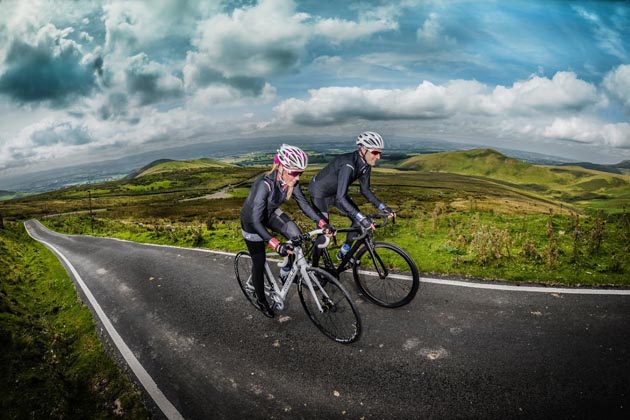
Great Dun Fell
Many of you will have ticked off the mighty Hardknott Pass, bagged the evil Rosedale Chimney, or maybe the savage Asterton Bank, and be pretty proud of your achievements on these vicious climbs.
Of course these are all worthy scalps, but Simon Warren, author of 100 Climbs and British bike brand Ribble Cycles have teamed up to bring you some lesser known, yet brutally spectacular roads lying out there waiting to torture your legs.
We’re not talking about the Alps, or the Pyrenees; right here in Britain. Hidden from view, tucked away behind locked gates, marked as dead ends, or even shrouded in cloud there lie Monsters.
Writhing upwards through gnarled woods and rugged rocks, switching back and forth across seemingly impossible gradients they take you to altitudes you may have thought impossible on this geologically stunted island.
These five roads will deliver you to places so wild and reveal views so spectacular you’ll scarcely believe they exist, but boy you’ll have to work hard to reach their summits. These climbs are not for the faint hearted, nor for the ill-prepared or the unready, they will test even the strongest rider to the limit so fit a compact at the front and the biggest sprocket you can find at the back and get ready for some British climbing ‘shock and awe’.
British bike brand Ribble Cycles has teamed up with Simon Warren, author of 100 Climbs, to bring you guides on top places to ride, making the most of amazing British countryside
Great Dun Fell, Pennines
Length 7450m
The latest race content, interviews, features, reviews and expert buying guides, direct to your inbox!
Height gain 632m
Average gradient 9%
Maximum gradient 25%
Strava https://www.strava.com/segments/5167327
If you’ve heard of any of these roads, it’s likely to be this one, the imperious Great Dun Fell, Britain’s answer to Mont Ventoux. The 7.5 kilometre journey up its sinuous tarmac to the ‘top of the world’ is without doubt one of the greatest experiences you can have on two wheels in England. Be warned though, like all giant climbs, conditions at the top are very rarely the same as they are at the base and clear skies are a rarity at this altitude in the Pennines, so always pack a jacket.
As you leave the tiny village of Knock glance up and on the horizon you’ll see, if the weather is kind, the glowing white sphere of the radar station, this is your goal, your target. As you pick your way along the rough sliver of a road that divides the rugged farm land annoyingly there are two gates to cross, (although they are sometimes open), so be warned.
There are a number of plateaus along the way and although they offer some respite they also accentuate the severity of the climbing that follows them. With multiple sections over 20% by the time you reach the finale your legs will be screaming, and what a finale it is. At the point where public vehicles are no longer allowed the surface changes to silky smooth as it hits a 25% slope nestled between high grassy banks.
Push up through these to reach an exposed plateau leading to the giant ‘golf ball’ in the sky surrounded by simply epic views of the Pennine Fells.
Abdon Burf, Shropshire
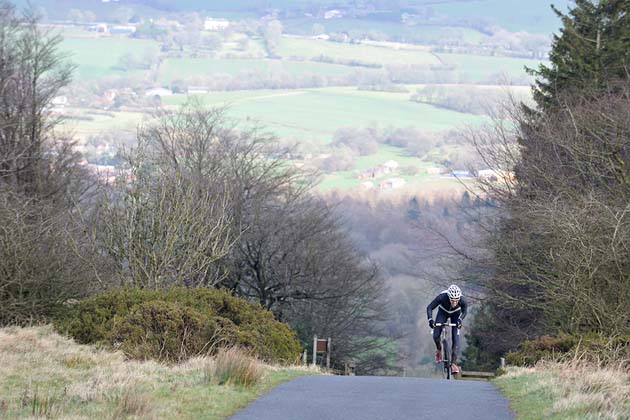
Length 1850m
Height gain 208m
Average gradient 11%
Maximum gradient 25%
Strava https://www.strava.com/segments/1032795
Be warned, arrive at the base of this road on a heavy bike with a standard 39/27 and you will suffer. Simon Warren says: “I was gob struck when I saw what faced me once I’d straddled the gate at the base, it is simply ridiculous.
In front of me lay an arrow straight line of 20-25% slope, no respite, no deviation just a direct line of pain, and it beat me. I put my foot down not once, not twice, but three times. Unable to continue my forward motion I was crestfallen, no climb can get the better of me, it just can’t, I was decidedly dejected. I then realised that if it had hurt me this much it would also hurt everyone else too, so cheered myself up with the thought of telling the world about it so others could share my pain.”
As it’s not open to traffic you will have the road to yourself but the downside of this is that it’s covered in a film of debris and slippery leaves, which if wet, just amplify your struggle for traction. Beat it though, crack the initial 800 metres of torture and you arrive at the most glorious plateau of hillocks sat high above the rolling Shropshire countryside.
Home to some of the best views in England this lost world of pristine grassland and abandoned buildings is just magical. Once you’ve climbed your way up to the communication towers, dismount, then continue the short distance on foot to the small stone marker from where you’ll be presented with jaw dropping 360 degree views.
Lowther Hill (plus the Mennock Pass), Scotland
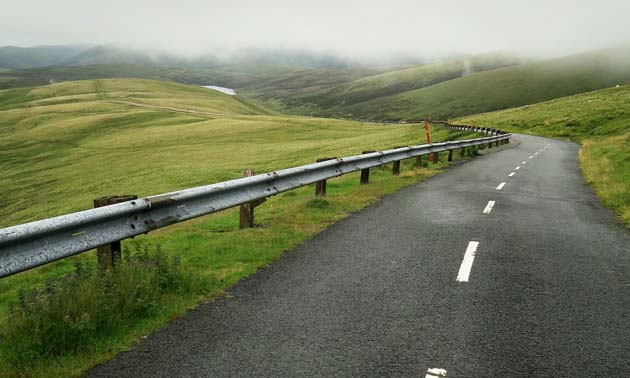
Length 15200m
Height gain 611m
Average gradient 4%
Maximum gradient 15%
Strava https://www.strava.com/segments/1367493
If great Dun Fell is England’s Mont Ventoux, then Lowther Hill is Scotland’s Great Dun Fell, although not as steep as its English counterpart it’s every bit as spectacular. If you combine the climb with the ascent of the Mennock Pass, from base to summit you get close to 15km of climbing; that’s longer than Alpe d’Huez.
“Surely not, not in Britain,” you cry. Oh yes! The first 11 kilometres out of Mennock rising to the village of Wanlockhead are relatively mild, but these steady, beautiful slopes are just the warm up, the starter for the following main course.
It’s when you leave the B797 that the real fun begins taking a right turn into splendid isolation on a silky smooth road to the sky. Following negotiation of the heavily padlocked gate (don’t worry it’s perfectly fine to ride up) you can begin your journey, twisting, and rolling across the silence of the empty hill sides high above the world below.
The further you climb the more Alpine it feels as you rise from the surrounding hills searching out the huge spherical radar at the summit. Never too steep but always epic this final four kilometres are a pure joy to experience and if the organisers of our national Tour are listening, would make the perfect stage finish, we reckon.
Kit Hill, Cornwall
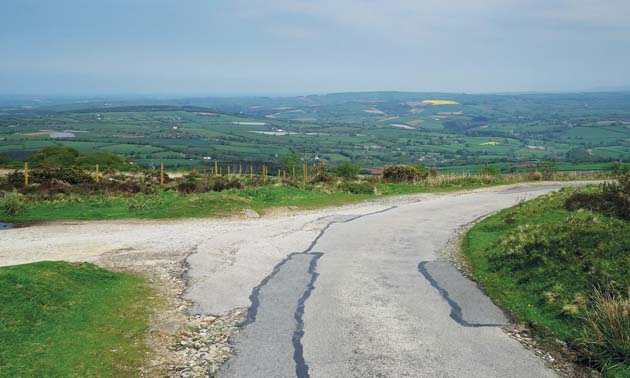
Length 3475m
Height gain 294m
Average gradient 8.5%
Maximum gradient 20%
Strava https://www.strava.com/segments/8754252
Approaching this climb, you can see the ornate chimney that marks its summit for miles from all directions. The challenge is how to find the best route to reach it, and by best of course, we mean hardest. This requires locating the village of Luckett that lies in the valley close to the River Tamar. Starting your accent here will reward you with close to 3.5 kilometres of climbing with an average of 8.5%. Ouch.
Between the village and the B3257 on the ridge ahead you’re spoiled by an abundance of 20% gradient, on and on it climbs with little or no let up until you reach the junction. With legs of Jelly it’s now time to head to the top and once over the main road, continue straight on for a few hundred metres, always climbing, then turn right.
Here the road narrows to little more than a car’s width and punctuated by primitive speed bumps climbs towards the summit. No matter how hard you find it the views that appear as you climb are enough to distract you from any amount of discomfort, they are simply magical. The higher you rise above the rolling Cornish hills the more spectacular the vista until you are presented with a 360 panorama to match anything you can reach on a road bike in England.
The Cowlyd, North Wales
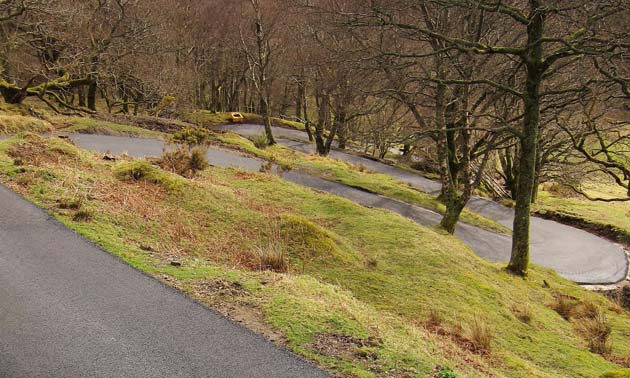
Length 3150m
Height gain 410m
Average gradient 13%
Maximum gradient 25%
Strava https://www.strava.com/segments/8567419
“If I’d had the energy left to cry when I reached the top of this road then I would, it just broke me, it’s insanity,” says Simon Warren. “Easily the toughest stretch of tarmac I’ve ever ridden this side of The Angliru, (the famous mountain in northern Spain).”
Forget the steep gradient sign at the base, The Cowlyd, should come with a government health warning. Creeping inconspicuously out the back of Trefriw the slope soon ramps up to 20% and just stays there. On and on for close to 3km this purgatory continues. Usually a 100 metres of slope this steep on a climb is enough to make it a killer, to have this much brutal gradient is simply madness.
In its favour it does pass through wonderful rugged scenery and is packed with twists and turns, at one point packing six hairpins into the space of about 500 metres. If you can get to the top you’re doing well, if you can do so without stopping you’re doing very well.
Leaving the last of the tough stuff behind the higher slopes are comparably mild then once you reach the top your reward is the sanctuary, and emptiness of Snowdonia.

Nigel Wynn worked as associate editor on CyclingWeekly.com, he worked almost single-handedly on the Cycling Weekly website in its early days. His passion for cycling, his writing and his creativity, as well as his hard work and dedication, were the original driving force behind the website’s success. Without him, CyclingWeekly.com would certainly not exist on the size and scale that it enjoys today. Nigel sadly passed away, following a brave battle with a cancer-related illness, in 2018. He was a highly valued colleague, and more importantly, an exceptional person to work with - his presence is sorely missed.